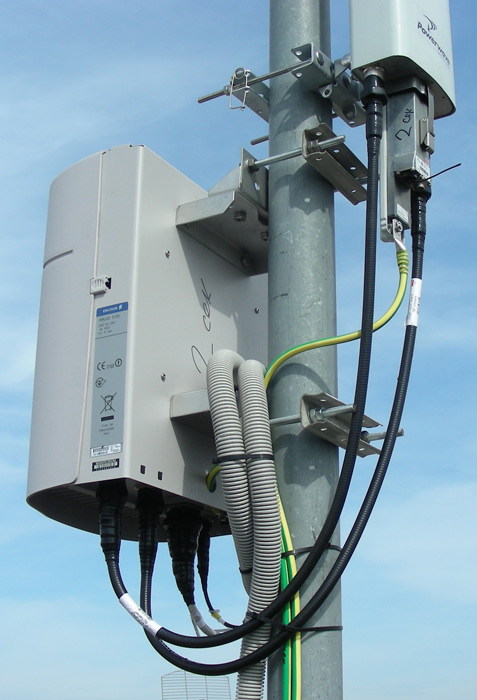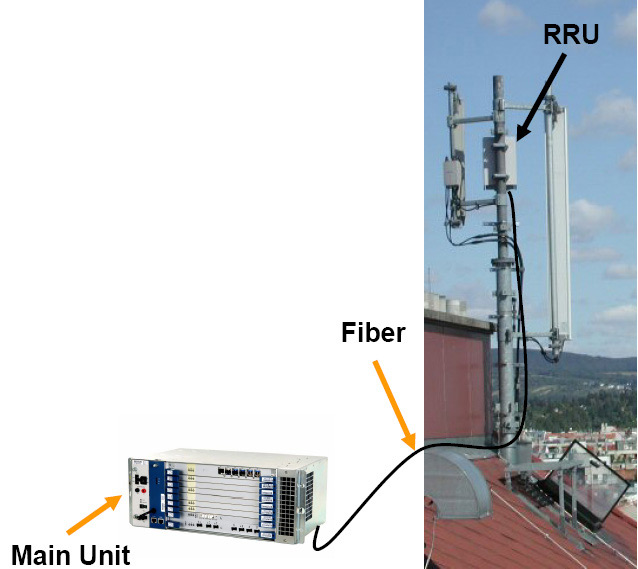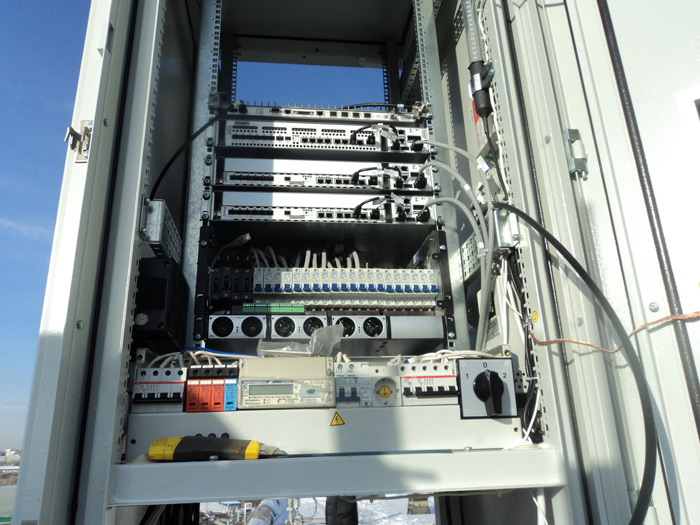Energy saving technologies in practice

Part of a distributed base station
Energy saving technologies, or "green technologies" - this is one of the priorities of our sphere . I will talk about what we have already done and how concrete solutions work that allow us to save quite a lot of energy.
Many believe that "green energy" is only wind power generators, solar panels and hydroelectric power plants. In practice, today this technology also includes everything that uses data analysis and any solutions that save energy.
')
Why is a wind turbine or solar battery - is it exotic?
There are enough places on the territory of Russia where it is possible to apply “green” electric power industry and get benefits, but only with a proper assessment of the region’s capabilities. In most situations, electrical installations on wind turbines and solar batteries are more expensive than conventional power from the public grid (50 Hz). Expensive not only the equipment itself: for the creation of an electrical installation, large-scale studies are required, which allow to determine which equipment will be optimal for use in this particular place. These studies include the analysis of terrain, wind parameters, solar activity.
As a rule, data on the climatic characteristics of a region are provided by local branches of the Hydrometeorological Center, provided that they have observation points in the right place. As a result, on the basis of aggregate data, a general calculation of the energy potential of the region is carried out. Plus, the power of reserve generators on liquid fuel is calculated, the optimum reserves of fuel are calculated on the basis of statistical data on the length of time with unfavorable climatic factors. Estimated access paths to the BS to provide backup fuel. If this analysis is not performed, there is a risk to install either insufficiently powerful equipment, or vice versa, with excessive potential. Accordingly, there will be no savings in this case.
Most of the cost of electrical installations on windmills and solar batteries is the cost of special batteries with an increased charge / discharge cycle (hydrogen production is currently an experimental technology, there are no industrial solutions).
Today the situation is such that the problem of electrical supply of communication objects can be solved without large-scale attraction of alternative energy sources. Even in places where there is no public grid, there are alternatives to natural sources of energy. Possible options:
- Places where there are subscribers, but where it is difficult to supply power . For example, the islands in the Volga delta, where there are camp sites. The recreation center usually has its own substation, from which it is logical to power the base station. It would be interesting to put a wind turbine (the winds there are very frequent), but the ground does not allow it.
- Federal highways. They are really difficult to provide power to the base station, but in most cases it is possible to negotiate with other services. For example, in the _Amur_ project, some of the stations at the time of launch worked from diesel, but later all of them were transferred to power from the Russian Railways lines, from local power engineers, and so on.
- In all other cases , the same principle applies: where there are people, there is infrastructure and power, which can be used for base stations.
There are base stations with windmills, solar panels, and other exotic - but they can hardly go into the series and be scaled to the entire network. Therefore, the main work is carried out in other directions. Consider the most interesting options, but let's start with the usual solar panels.
Energy of sun
Solar panels give off energy, converting sunlight, charge the battery and power the equipment. At night, the batteries do not work, and the equipment is battery powered. If fog gets up in the morning or it starts to rain, the batteries will not be able to charge, the battery will not be charged, and the station will stop working. We have a solar-powered station , but even in a region with a very sunny climate, it often switches to diesel when several cloudy days are issued in a row.
The result is that for commercial operation solar cells without a second line are not yet suitable. Considering that the cost of the second line is usually several times less than the cost of batteries (unless the fuel is supplied by a helicopter), then the area of their application is very, very limited.
Two factors can change the situation: first, the appearance of “long-playing” cells, and, secondly, the appearance of more capacious, and more importantly, battery temperatures that are more adapted to the differences. The fact is that the cells that exist now can show themselves very well in the first year of operation, but significantly reduce the performance later. Now, tests of a new generation are being held in some places, but we have to wait another year before evaluating the result. Just good cheap large-capacity batteries will do a lot for green energy: they are usually the most expensive and whimsical part of the complex, so changes in technology will make many projects worthwhile.
BTS Power Saving
Most of the electricity in the base station is consumed by transmitters with a rather low efficiency. Here the principle is very simple: if you need to provide a certain coverage (the necessary signal size for reliable reception at the calculated distance from the antenna), then you need to give a certain signal power. The transmitters themselves cannot be touched to reduce the transmit power and save power consumption. Circuit design of transmitters, in fact, reached the limits of efficiency. But! Transmitters at base stations operate in arrays: the more phones and other terminals in a cell, the more transmitters are required. The obvious solution is to activate the software directly at the base station, which will turn off unused transmitters and make optimal use of the included ones.
The BTS Power Saving option is an additional functionality offered by the BS vendor and activated by software. About a couple of years ago we started tests of such functionality. We launched a dozen base stations using various vendors, six months we recorded data from them, and then we started switching to this functionality on the entire network. Last year, all new VimpelCom base stations are being installed with BTS Power Saving .
Distributed base stations
Approximately half of the base station's power consumption may be in cooling. Cooling is needed primarily for transmitters. Accordingly, at some point an idea appeared to bring the transmitters out so that they would be cooled with outside air.
The result - a single control module is installed in the hardware. Remote RRUs are fixed near the antenna and are connected to the module by a fiber-optic transmission line. The control module is placed in a special thermal box, which is cooled by heat exchange with external air. Such distributed base stations performed well in the middle lane, and in the conditions of the north.

The principle of constructing a normal BS on the left, distributed - on the right.


Optical fiber systems have significantly lower signal loss than copper. By increasing the radiated power in the antenna, we can increase the coverage area of the base station. The very replacement of the copper cable is another big advantage of distributed BS. Copper is replaced by optics - this means that natural resources are being saved. Given the relatively large savings of electricity, the new distributed type base stations are now installed in the network where operating conditions allow.
Freaking
He described my colleague in detail about the cooling of the data center in some detail about how the system of forced-air ventilation (free cooling) works. In short, the right choice of a region with the right climate and proper cooling due to external air makes it possible to save a few megawatts of electricity when sold on the network as a whole. This is an example of a large project, but free cooling is being implemented at base stations. The technology is applicable practically throughout the territory of Russia. Now freaking is gradually being introduced everywhere.
Dynamic UPS
Another environmental solution is the use of kinetic energy storage devices of uninterrupted power supply instead of traditional batteries. These are generators equipped with inertial systems. When the main power is turned off, the accumulated energy allows the system to keep working for a short period of time, until the backup source is connected. The technology is more efficient and modern in comparison with the classic UPS. This technology is applicable primarily at large sites , for base stations it is not justified.
You can reduce the power transmission losses on the way from the transformer to the IT load by a few percent, plus save at least 25% of the space for the placement of power equipment. The battery pack (in this case, a kinetic drive) does not need to be replaced - it means that complex recycling is not necessary either.
Saving battery temperature
As you know, batteries are quite capricious in terms of the allowable temperature range of operation. For every 10 degrees of temperature increase relative to the norm, the battery life is shortened by 2 times, but at the same time, the capacity increases. Accordingly, to maintain the temperature, systems are required that provide automatic cooling or heating.
A slight increase in temperature in the equipment room, from +22 to +25 degrees, has virtually no effect on battery life, but it also saves energy. We have conducted similar studies and are already saving 2-3% of the power consumption of the entire network precisely on such a change in mode. It may seem that 2-3% is not enough, but given just huge amounts of energy needed to power the network, it is really worth it.
To maintain the desired temperature, batteries can also be placed in special thermal boxes, and less energy is spent on maintaining the desired mode in the equipment room. If the battery is protected by a thermal box, then the temperature in the equipment room may be higher than it was previously assumed (when there was a battery in it) - this does not affect the performance of the system.

Thermobox
Statistics
- Option BTS Power Saving - gives 3% savings.
- Installation of Free Cooling systems - an average of 12%.
- Changing the settings of air conditioners at the base station to +25 degrees - up to 3.5%.
- The use of distributed base stations - 30-35% savings.
In terms of materials used in the construction of BS, environmental requirements for equipment and materials also play an important role. Deliveries of components are regulated by the legislation of Russia and the countries of manufacturers, so the use of some elements that do not meet environmental standards is simply impossible. In some aspects, Russian legislation is even tougher than foreign ones. All components are subject to sanitary-environmental certification in accordance with the legislation of the Russian Federation and supplying countries.
In parallel, we are introducing various organizational measures at the IT level — for example, in a large central office, computers at night are automatically put into sleep mode (many leave computers turned on).
Nearest technology expected
All industries, including communications, are eagerly awaiting everything connected with an increase in battery capacity, their cheapening or, which is also very important, an increase in service life (because they also require recycling). We control the information of the international market, collect data from all suppliers and manufacturers of equipment on opportunities for energy saving. Then, every opportunity is calculated, interesting solutions are launched into the test. For quality testing you need from six months to a year - to go through the entire seasonal cycle and see what happens with the equipment in different weather conditions and after quite a long load. Be sure to take into account the test reports of suppliers with the confirmation of the relevant certification authorities. In addition, we additionally check the equipment in those weather conditions that are possible in specific regions of Russia.
Source: https://habr.com/ru/post/154423/
All Articles